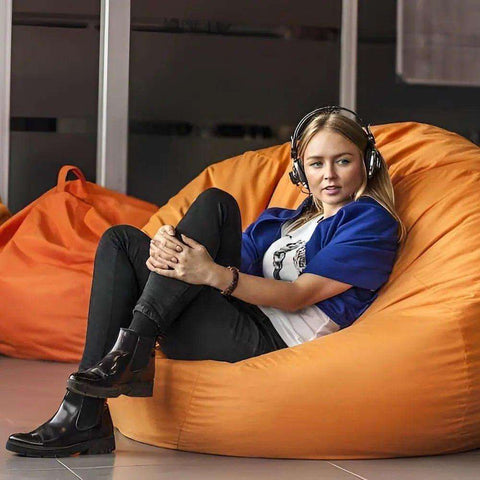Back pain affects millions worldwide, impacting quality of life. While treatments like medication and physical therapy are common, bean bags offer a comfortable, natural alternative. Can bean bags really reduce back pain?
This article explores the science behind bean bags and their potential to alleviate back pain. We'll examine their ergonomic design, pressure point relief, spinal alignment benefits, and enhanced blood circulation.
We'll also guide you in choosing the right bean bag, considering size, shape, filling material, and additional features for optimal comfort and support.
By the end, you'll understand how bean bags can provide a relaxing, ergonomic seating option for back pain relief. Let's delve into the science and discover if bean bags are the unexpected solution you've been seeking.
Can Bean Bags Really Reduce Back Pain?
Back pain is a widespread ailment with significant impact. This section explores its prevalence, causes, and conventional treatments.
A. Prevalence of Back Pain
Back pain affects people of all ages. The lumbar spine, or lower back, is the most commonly affected area. The Global Burden of Disease Study identifies lower back pain as the leading cause of disability worldwide, with up to 80% of adults experiencing it. Non-specific low back pain is most common in people aged 35 to 55 years. Whether mild or chronic, its impact is profound.
B. Causes of Back Pain
Factors contributing to back pain include poor posture, sedentary lifestyles, obesity, and muscle imbalances. Poor posture and strain can affect the facet joints—small joints connecting the vertebrae that enable movement and bending of the spine, as well as the soft tissues in the back. Obesity can contribute to back pain by increasing strain on the spine. Muscle spasms are a common cause and symptom of back pain. Accidents, injuries, and medical conditions can also lead to back pain. Understanding these causes is crucial for effective pain relief.
C. Conventional Treatments
Conventional treatments often involve pain medications, physical therapy, and, in severe cases, surgery. Pain relief medications can aid in keeping people active despite back pain. Nonsteroidal anti-inflammatory drugs and muscle relaxants are commonly prescribed for pain relief and to alleviate muscle spasms. While providing temporary relief, they may not address the root cause and can be costly, time-consuming, and have side effects. Back pain is diagnosed through physical examination and patient history. This drives many to seek alternative solutions. Most cases of low back pain resolve within a few weeks, but if pain lasts several weeks or becomes long-term pain, further advice from a healthcare professional should be sought.
Introduction to Back Pain
Back pain is one of the most common health complaints, affecting people of all ages and backgrounds. Whether it’s a sudden twinge after lifting something heavy or a persistent ache that lingers for months, back pain can disrupt daily life and make even simple activities challenging. The pain may be acute, lasting only a few days or weeks, or it can become chronic back pain, persisting for months and significantly impacting quality of life.
There are many reasons why back pain develops, from muscle strains and poor posture to underlying medical conditions. Recognising the type of pain you’re experiencing is the first step toward effective pain relief. Acute pain often resolves with rest and self-care, but chronic back pain may require a more comprehensive approach to reduce pain and restore mobility.
Because back pain can sometimes signal a more serious problem, it’s important to pay attention to your symptoms and seek medical advice if the pain affects your ability to perform everyday activities or doesn’t improve with basic care. Understanding the causes, symptoms, and available treatments empowers you to take control of your back pain and find the best strategies for relief.
The Science Behind Bean Bags
A. Ergonomics and Support
The science behind bean bags for back pain lies in their ergonomic design. Unlike traditional seating, bean bags are filled with soft pellets that conform to the user’s shape, creating a customized, comfortable seat. Maintaining good posture is important when sitting at home, in your workplace, or in your car, and bean bags can support this by adapting to your body’s natural contours. It is also important to keep your feet flat on the floor when sitting to help maintain proper spinal alignment.
This design adapts to your body’s natural contours, providing support where needed. Constant pressure reduces strain on specific areas, minimising the risk of developing or worsening back pain.
B. Pressure Distribution
Bean bags distribute pressure evenly across the body, eliminating pressure points common in traditional chairs that cause discomfort and muscle tension.
By moulding to your body shape, bean bags adjust to your weight and evenly distribute it, reducing back strain. This allows muscles to relax and prevents tension build-up.
C. Flexibility and Posture
Bean bags offer flexibility, allowing a greater range of motion and easy adjustment of seating position. This promotes healthier sitting habits and encourages better posture
By allowing your body to find its most comfortable position, bean bags can alleviate back pain caused by poor posture or prolonged sitting in uncomfortable positions. Slouching is bad for you and can make back pain worse, so using a bean bag to encourage better posture can be beneficial. Bean bags can also help prevent discomfort and back pain associated with poor posture during long periods of sitting.
The ergonomic design, pressure distribution, and flexibility of bean bags make them a potential solution for back pain, offering a unique approach to managing and preventing it. Additionally, bean bags may help address structural problems by supporting proper spinal alignment.
Benefits of Bean Bags for Chronic Back Pain
A. Relief from Pressure Points
Bean bags relieve pressure points by conforming to your body’s shape, evenly distributing weight, and alleviating strain. This provides a more comfortable sitting experience.
B. Improved Spinal Alignment
Bean bags’ flexible nature allows for natural movement and adjustment, promoting better spinal alignment. Unlike rigid chairs, they support the spine’s curves, reducing strain and tension.
C. Enhanced Blood Circulation
Bean bags improve blood circulation by allowing better movement and reducing pressure on blood vessels, preventing blood flow restriction and ensuring adequate oxygen and nutrients reach back muscles and tissues. This aids healing and alleviates back pain.
Incorporating bean bags can benefit those with back pain. Their ability to relieve pressure points, improve spinal alignment, and enhance blood circulation makes them a unique solution. Staying active is the most important way to help prevent back pain. Choosing the right bean bag and incorporating it into your routine may provide relief and a more comfortable, ergonomic sitting experience.
To further support your recovery and prevent future back pain, it is important to engage in physical activity and exercise regularly. Strengthening your core muscles through targeted exercises can help maintain proper spinal alignment and reduce strain on your back. Regular movement and activity, combined with ergonomic seating, play a key role in long-term back health.
Diagnosing and Treating Back Pain
When back pain strikes, getting an accurate diagnosis is crucial for effective treatment. A healthcare professional will typically start by reviewing your medical history and conducting a physical examination to pinpoint the underlying cause of your pain. In some cases, additional tests such as blood tests or imaging studies may be needed to rule out more serious conditions or to understand better what’s happening in your spine.
Once the cause of your back pain is identified, your healthcare provider will work with you to develop a personalised treatment plan. For many people, conservative treatments like physical therapy, pain relievers, and lifestyle adjustments are enough to manage symptoms and promote healing. Physical therapy can help strengthen the muscles that support your back, improve flexibility, and teach you how to move in ways that protect your spine.
For those with chronic low back pain, a multidisciplinary approach may be recommended. This could include medications, physical therapy, and alternative treatments such as transcutaneous electrical nerve stimulation (TENS), which uses mild electrical currents to help relieve pain. In more severe cases, or when conservative treatments don’t provide enough relief, other interventions or even surgery may be considered.
No matter the approach, it’s important to work closely with your healthcare professional to monitor your progress and adjust your treatment plan as needed. With the right support and a tailored strategy, most people can find ways to manage their back pain and return to their normal activities.
Choosing the Right Bean Bag for Pain Relief
To choose the right bean bag for back pain, consider these factors:
A. Size and Shape
Opt for a bean bag that supports your entire back. Ensure it's large enough to accommodate your body comfortably. Look for features like a tall backrest or lumbar padding for additional support.
B. Filling Material
Consider different bean bag fillings. Polystyrene beads conform to your body, while memory or shredded foam provides firmer support and relieves pressure points.
C. Additional Features
Look for adjustable straps, built-in lumbar cushions, or headrests for targeted support. Removable, washable covers help maintain cleanliness and hygiene.
While bean bags can relieve back pain, consult a healthcare professional for chronic or severe issues.
Alternative Therapies and Solutions
In addition to conventional medical treatments, many people find relief from back pain through alternative therapies and lifestyle changes. These approaches can be especially helpful for those dealing with chronic pain or looking to complement their existing treatment plan.
Acupuncture, for example, involves inserting fine needles into specific points on the body to stimulate healing and provide pain relief. Massage therapy is another popular option, as it can help reduce muscle tension, improve blood flow, and ease pain in the affected area. Cognitive behavioural therapy (CBT) offers a different approach, assisting individuals to change the way they think about pain and develop effective coping strategies.
Simple home remedies can also make a difference. Applying a heat or ice pack to the sore area can help reduce pain and inflammation—just be sure to avoid burns by using a towel or cloth as a barrier. Regular exercise, especially routines that strengthen the back and abdominal muscles, can improve posture and support the spine, making it less likely that pain will return. Maintaining a healthy weight and avoiding heavy lifting are also important steps in preventing further injury.
By combining these alternative therapies with traditional medical care, you can create a comprehensive approach to back pain relief that addresses both the physical and emotional aspects of pain. This holistic strategy can help you feel better, move more freely, and enjoy a higher quality of daily life.
Conclusion
Bean bags offer a unique solution for back pain relief. Their ergonomic design, pressure distribution, and flexibility make them an excellent choice for comfort and support. Invest in a bean bag that prioritises your back health and experience the difference today.




